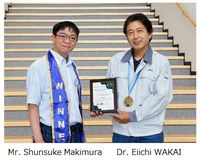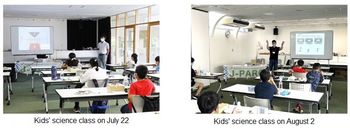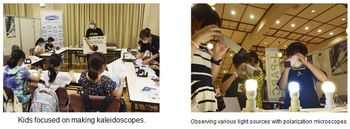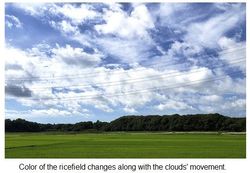J-PARC News September 2022(Issue#208)
■International Association for Science Network “International Best Researcher Award in Materials Science 2022”
A research paper written by Dr. Eiichi Wakai (Materials and Life Science Division), Mr. Shunsuke Makimura (Particle and Nuclear Division), and co-authors, published in the Journal of Nuclear Materials, won the International Best Researcher in Materials Science Award 2022. This award was selected by the international committee of the International Society for Science Network (ISSN), which is based in India, and was selected from among approximately 10,000 papers from around the world. The award ceremony was held on June 4, and the plaque and medals were delivered to them after the ceremony.
The award-winning research provides a systematic and detailed consideration beyond conventional knowledge and understanding of material irradiation damage, from structural materials for innovative nuclear power systems to materials for high-intensity accelerator target systems, through the results of various irradiation experiments and computer simulation analyses. This research has been accomplished through collaborative studies among researchers and engineers at J-PARC and domestic and international organizations, including research groups by Dr. Kazumi Aoto (former Executive Director of JAEA), who specializes in fast reactor structural materials at JAEA.
The results will contribute to understanding microstructural and mechanical property changes that occur in materials used in various equipment at high temperatures, even down to the atomic level. As a result, the paper is beginning to be cited in prominent materials and chemistry journals outside the nuclear materials field.
Publication information: E. Wakai et al., Journal of Nuclear Materials 543 (2021) 152503: https://doi.org/10.1016/j.jnucmat.2020.152503
■IEEE Award for Continuing and Significant Contributions in the Field of Applied Superconductivity
Dr. Toru Ogitsu of the Cryogenic Section at J-PARC Center has received the 2022 Award for Continuing and Significant Contributions in the Field of Applied Superconductivity from the IEEE (Institute of Electrical and Electronics Engineers), which is given to a person who has made a significant contribution to the field of applied superconductivity. Dr. Ogitsu developed, constructed, installed, and commissioned the superconducting magnet system for the J-PARC neutrino experiment based on an innovative design of combined function (having both beams bending and focusing functions) superconducting magnets. Then the award was given in recognition of his significant leadership and success in global collaboration.
■Lithium diffusion in Solid-State Lithium Battery Anode Material Observed Using Positive and Negative Muons(July 7)
A research group consisting of High Energy Accelerator Research Organization’s (KEK) Institute of Materials Structure Science and other institutes has investigated the diffusion of lithium ions in Li4Ti5O12, which is a candidate anode material for solid-state batteries being developed as next-generation batteries, using the muon spin rotation and relaxation (μSR) method with intense positive and negative muon beams at the J-PARC.
Since lithium ions should transfer in lithium-ion batteries, studying the diffusion of lithium ions is essential for understanding fundamental battery reactions and developing new battery materials. The ion diffusion coefficient, which is considered an important indicator in determining battery performance, has conventionally been determined by electrochemical measurement. However, since diffusion coefficients are highly dependent on measurement conditions such as material composition and electrode size, it is impossible to obtain the diffusion coefficients specific to electrode materials actually used in lithium-ion batteries by electrochemical measurement. The μSR method can capture variations in the internal magnetic field due to the diffusion of lithium ions, and thus provides information on the internal magnetic field at the interstitial site near the oxygen in the spinel lattice in mSR with positive muons (m+SR), and the internal magnetic field at the oxygen site in mSR with negative muons (m-SR).
The μSR measurement results for both positive and negative muons show that the internal magnetic field becomes dynamic with increasing temperature. Since negative muons do not move from their nucleus positions, the results of m-SR measurement clearly indicate that lithium ion diffusion occurs in the anode material Li4Ti5O12. The results of m+SR measurement also suggest lithium ion diffusion, and their difference from the m-SR results might be attributed to positive muon diffusion. Both positive and negative mSR measurements showed low activation energy, confirming that Li4Ti5O12 is an excellent anode material. It is expected that this research will be extended into an operand μSR measurement under battery operating conditions, which will contribute to the research and development of high-efficiency batteries and new materials.
For more information, please visit the J-PARC website: https://j-parc.jp/c/press-release/2022/07/07000974.html
■Visualization of Water Inside Automotive Fuel Cells Using Pulsed Neutron Beam for the First Time
-Contributing to the Reduction of Greenhouse Gas Emissions by Improving Fuel Cell Performance (July 12, 2012)
Using the pulsed neutron beam at J-PARC, we succeeded in visualizing the behavior related to the generation and evacuation of water inside a full-size fuel cell installed in a fuel cell vehicle. This research was conducted as part of the "Industry-Academia-Government Collaboration Research and Development Project to Solve Common Problems for Dramatic Expansion of Fuel Cell Utilization" of the New Energy and Industrial Technology Development Organization (NEDO) to advance fuel cell analysis technology.
Fuel cells are clean energy devices with high efficiency in power generation and emit only water during power generation because they use a chemical reaction between hydrogen and oxygen. For this reason, fuel cells are expected to be a key technology for achieving carbon neutrality. However, if the water generated during power generation stays inside the cell, it blocks the supply pathways for hydrogen and oxygen gases, leading to reduced power generation performance. Owing to that, developing flow paths and electrode structures that can efficiently drain water out of the cell becomes a challenge. Since neutrons have a high penetration capability for materials and high sensitivity to light elements such as water, they have been expected to directly observe water behavior.
In this research, by upgrading the imaging equipment consisting of an optical image intensifier and a CMOS camera and optimizing the imaging conditions, we succeeded in visualizing the behavior of water inside a fuel cell-cell of actual size in a second, which is one-tenth of typical exposure time with the conventional imaging equipment, while maintaining a high spatial resolution of 300 μm using the neutron imaging system "RADEN" at J-PARC. Then this enables visualization of the behavior of water in the gas channel paths inside the fuel cell in near real-time. Moreover, it can also be used for various applications, such as distinguishing between water and ice inside the cell and visualizing the macroscopic behavior of water in combination with its detailed analysis.
For more information, please visit the J-PARC website: https://j-parc.jp/c/press-release/2022/07/12000975.html
■J-PARC Hello Science "Form and Motion of Giant Molecules" (July 29)
In July, Dr. Hiroyuki Aoki of the Materials and Life Science Division served as the lecturer for Hello Science, introducing his research on macromolecules. Polymers, such as polyethylene, nylon, and cellulose, are materials made of very large molecules. The unique properties of polymers originate in the fact that each of these large molecules can take on various shapes and move. In this event, he explained the properties of rubber like a liquid (viscosity = property of flow) and those like a solid (elasticity = property of return to the original state) by the experiment that the temperature of rubber rose when it was stretched and fell when it was shrunk, and using slime in an easy-to-understand way. He also introduced that the research on the contradictory properties of rubber, rolling resistance, and wet grip, led to the design of fuel-efficient tires. The most important issue in polymer chemistry is to observe the shape of molecular chains. Therefore, Dr. Aoki colored only one of the polymer chains and observed the stepwise structure by using neutron scattering and optical microscopy depending on the purpose. Then by directly observing the shape of the deformed chain, he was able to clarify the property that the polymer near the interface is hardly deformed, unlike the inside. The properties of interfaces have been actively studied in the industry in recent years, and these results have been utilized in the development of composite materials and adhesive technology. The audience and online participants asked many specialized questions, indicating their expectations for the field of materials development.
■Exhibited at "Eco-Fest Hitachi 2022" (July 23)
We exhibited a booth at "Eco Fest Hitachi 2022" held at Hitachi Civic Center and other venues for the first time in three years. ECOFES HITACHI is one of the largest environmental events in the Ibaraki prefecture, where people can learn through experiments and hands-on experience. About 50 companies, organizations, schools, and other groups reported on their environmental activities and introduced their environmental products at booths where visitors could enjoy and learn about them. J-PARC exhibited a superconducting coaster, a model of J-PARC, posters, etc., and attracted nearly 400 visitors. The superconducting coaster was so popular that visitors had to wait for their turn to try it out, and they stopped walking to watch as the coaster floated in the air and ran on the rails.
■"Let's Make a spinning top tilting and turning" at Tokai Village Enjoy Summer School 2022 (July 22 and August 2)
In the Enjoy Summer School organized by Tokai Village, J-PARC held lectures on making a top as last year. 16 and 13 fifth and sixth graders gathered at the Tokai Village Library on July 22 and August 2, respectively.
First, they learned about the relationship between electricity and magnetism by placing compass magnets side by side and observing how the direction of a magnet changed when a magnet was placed or when an electric current was applied to a coil. Then, they confirmed that the rotation of the axis of the tops changed when the tops were rotated while tilted or by changing the center of gravity of the tops. The lecturers explained that this was called precessional motion and that it was similar to the spin behavior of elementary particles studied at J-PARC.
■“Let's make a kaleidoscope of light" craft class on Kids’ Kasumigaseki Field Trip Day 2022 (August 3 and 4)
The "Kids’ Kasumigaseki Field Trip Day" is a collaborative event among government ministries and agencies located in Kasumigaseki to provide opportunities for children to experience and learn about society at large during their summer vacation, and to deepen the relationship between parents and children. Over the two days, 265 parents and children gathered at the JAEA booth in the venue to learn about the principles of spectroscopy by making kaleidoscopes of light.
Participants assembled their kaleidoscopes by drilling star-shaped holes in black paper and folding cardboard. When the completed kaleidoscope was turned toward the bright side, rainbow-colored light was seen above, below, left, and right of the star-shaped holes. Then we asked attendees to look through the various lights in the hall and list the similarities and differences in the spread of light and the arrangement of colors.
■Announcement of J-PARC Online Open House 2022 (August 27, 10:00 - 15:00) 
On August 27 (Sat.), "J-PARC Online Open House 2022 -Online only! The deepest part of J-PARC” will be open to the public! -It will be streamed live on YouTube and Nico Nico Live Broadcast. Please come and watch. You can also view the archive after the live streaming.
For more information, including the timetable, please visit this special page: https://j-parc.jp/c/OPEN_HOUSE/2022/
***This event was over successfully. Please visit our special site to view the archive. ***
Sanpomichi ㉖ - Rice Paddies of Masakiura 
Tokai Village has few ups and downs. As far as I know from a map, the highest point is 36m of Gongenyama above sea level. Roughly speaking, the lowlands are rice fields, the flat areas on the plateau are vegetable fields, and the border between the two is a little wooded area.
The photo below is a shot of the rice fields of Masakiura, which is one of the Twelve Views of the Tokai Region. Its land was originally an inlet, and reclamation of the land began in the Ansei era and was completed in 1938. Its plateaus beyond the rice paddies are not high, and the entire sky over the rice paddies here in Tokai Village looks very low.
In August, when the wind blows, the leaves of the rice plants and the flowers quietly blooming in them, sway one after another like a rippling ocean. Torn clouds passing through the blue sky cast huge shadows on the green that had been shining in the strong sunlight, and they move along at a considerable speed. From moment to moment during the morning and the evening, the entire rice paddies change colors along with the inclination of the sun. In the mostly flat terrain of Tokai Village, the scenery of these rice paddies seems to reflect a surprisingly dynamic figure.







